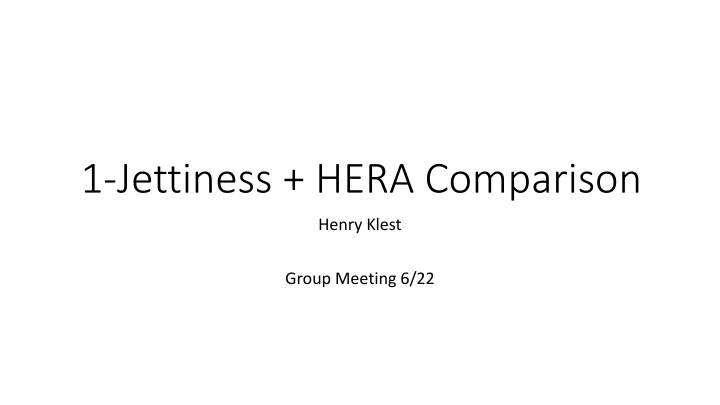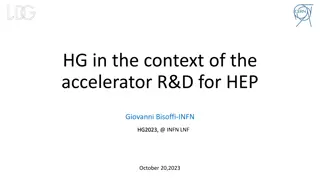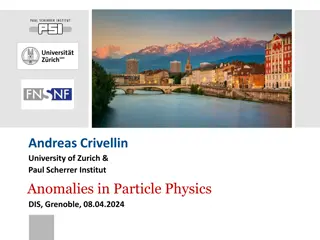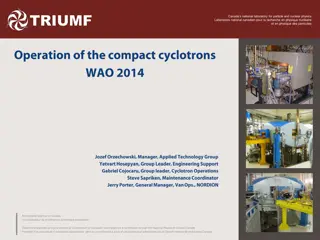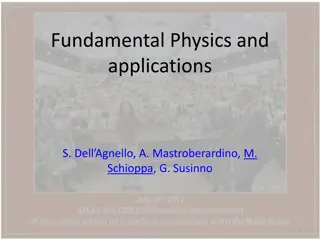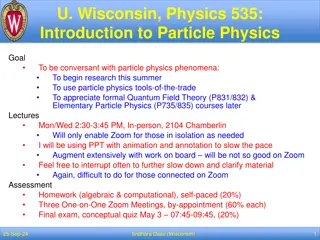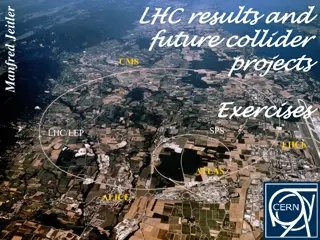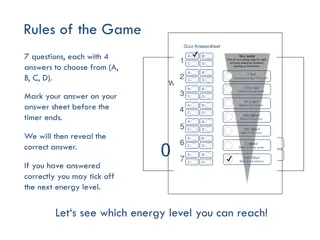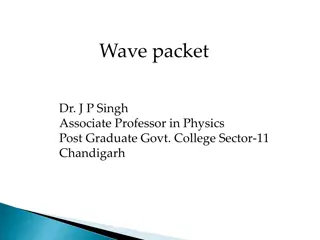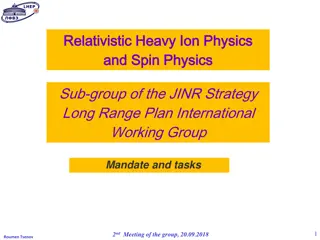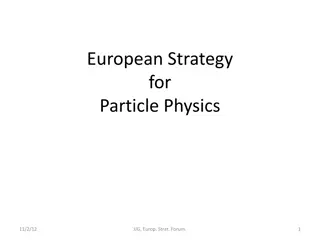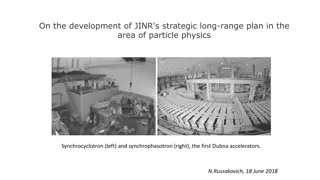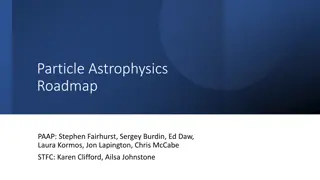Overview of Jettiness and Breit Frame in Particle Physics
This content delves into the concepts of jettiness and the Breit frame in particle physics, discussing their significance in experimental measurements and event shape observables. It explores how these concepts are utilized in experiments, particularly focusing on measurements within current and remnant hemispheres. The discussion also touches on the transformation to the Breit frame, longitudinal momentum components, and measurement techniques for jettiness in deep inelastic scattering (DIS). Overall, it provides a detailed insight into these essential aspects of particle physics research.
Download Presentation

Please find below an Image/Link to download the presentation.
The content on the website is provided AS IS for your information and personal use only. It may not be sold, licensed, or shared on other websites without obtaining consent from the author.If you encounter any issues during the download, it is possible that the publisher has removed the file from their server.
You are allowed to download the files provided on this website for personal or commercial use, subject to the condition that they are used lawfully. All files are the property of their respective owners.
The content on the website is provided AS IS for your information and personal use only. It may not be sold, licensed, or shared on other websites without obtaining consent from the author.
E N D
Presentation Transcript
1-Jettiness + HERA Comparison Henry Klest Group Meeting 6/22
The Breit Frame + Thrust Breit frame, infinite-momentum frame or brick wall frame Frame in which struck quark has momentum reversed CH RH In Breit frame DIS, you have the quark getting its momentum reversed and the proton remnants continuing forward. This lends itself to a measurement of hemispheres in Breit frame, corresponding to participant quark vs. remnant, so called current hemisphere (CH) and remnant hemisphere (RH)
Aside: Breit Frame Transformation If the scattered lepton is measured accurately, the lorentz transformation to the Breit frame can be made from the lab frame Need to learn x, q from lepton For EIC, may need to learn P and Ee from t0 due to crab crossing? By finding Q2 and y from lepton, x and q are defined. Lepton energy scale is a very important systematic in BF studies
The Breit Frame + Thrust This version of thrust (below; as used by HERA experiments) measures the longitudinal momentum components of particles in current hemisphere projected onto the current hemisphere axis Note: Variable can also be studied in e+e-! This crucially omits the remnant hemisphere, making it non-global n = boson direction Ph = hadron momenta in CH CH RH n CH RH Situation where = 1, longitudinal projection of CH particle momenta onto hemisphere axis is 0, high thrust in current direction Situation with low thrust, high spherocity another event shape variable effectively opposite of thrust n
1-Jettiness Event shape observable with theoretical calculation uncertainty of the order of 1%, sensitivity to s and PDFs (non-perturbative parameter 0?) To be compared to inclusive/dijet extractions in DIS with uncertainties of ~10% 1-jettiness in DIS measures final states with beam radiation + one additional jet, NOT the same as thrust from above, remnant is included in measurement Measure 1-Jettiness cross section with high precision, theory does the rest. Caveat: Larger systematic error due to non-cancellation of hadronic energy scale (unlike in thrust) Put simply: minimizing dot products W.R.T beam or jet = group into hemispheres based on which 4-vector is closest, beam or jet Working with 4-Vectors, so mass plays a role -> PID!
1-Jettiness in the fixed target frame 1-Jettiness in the center- of-momentum frame EIC Lab frame will be somewhere in- between (HERA had lab-to-CM boost of = 2.86)
1-Jettiness and s s is the only coupling parameter in QCD, needs to be experimentally measured and checked in as many channels as possible Unique running of s is a byproduct of the complexity and richness of QCD Measurement of s through standard knockout DIS, calculable to N3LL Crossing symmetry with e+e-, h+h collisions
1-Jettiness Many lessons to be learned from HERA, where similar event shape observables were readily measured in DIS EIC has an advantage due to luminosity, lower higher-order cross sections (dipole DIS etc.), ability to vary collision energy, hopefully better detectors e+h fixed target experiments generally haven t had enough ? to produce jets regularly and separate them in the lab frame (also detectors often non- hermetic) EIC in conjunction with theoretical improvements can likely provide significant improvement on uncertainty over HERA, (HERA and LEP* measurements dominated by theoretical uncertainty, revisit/combine with EIC measurements?) LEP value Exp. Uncert. Theo. Uncert *Might be fun to look at data from an experiment that shut down when I was 5
1-Jettiness For the Yellow Report, it s necessary to quantify the feasibility of this measurement at the EIC to see whether or not it s worth including in the physics program. My small contribution is to dig into HERA experiments and quantify the ways in which the EIC can make the measurement more or less precisely than they did. Big question: why did they only analyze HERA I data? Total of 82.2 pb-1 integrated luminosity from HERA I analyzed by ZEUS (in 2006) and 106 pb-1 from HERA I from H1 (in 2006) < 2 days of EIC run time at initial luminosity if my math is correct. 10 fb-1/183 days (6 months), 55 pb-1/day Possible that at the time, theoretical uncertainty still dominated experimental so nobody wanted to spend their time improving on the measurement.
Extraction of s in any channel is a delicate balance of complicated theory (scheme dependences etc. that I don t understand) with experimental measurements In principle, if Chris Lee and collaborators are correct about the precision of their calculations, simply re- analyzing HERA in terms of 1- Jettiness could yield a significant improvement in the uncertainties
PS: Axions? https://arxiv.org/abs/2006.09721 Paper published a few days ago by XENON 1T Observation of Excess Electronic Recoil Events in XENON1T The solar axion model has a 3.5 significance Axions provide a neat explanation for the strong CP problem, namely why should the parameter contributing to CP-violation in QCD be so darn small? (Current limit is < 10-10 radians) Highlights the huge variation in experimental techniques used to test QCD! 3.3 tons of ultra pure liquid Xenon! as usual, grains of salt abound.
